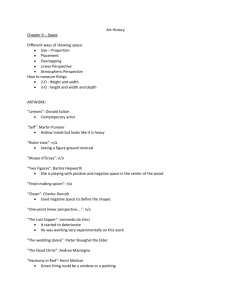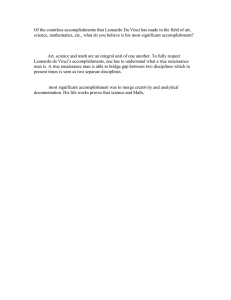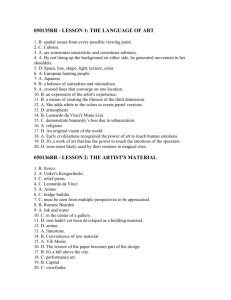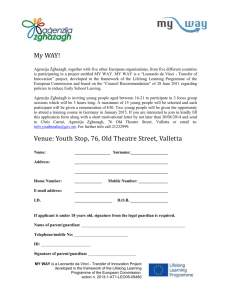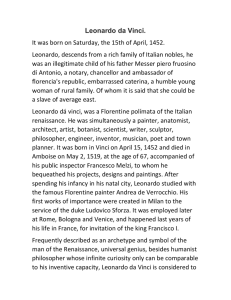Untitled - The Clos Lucé
advertisement
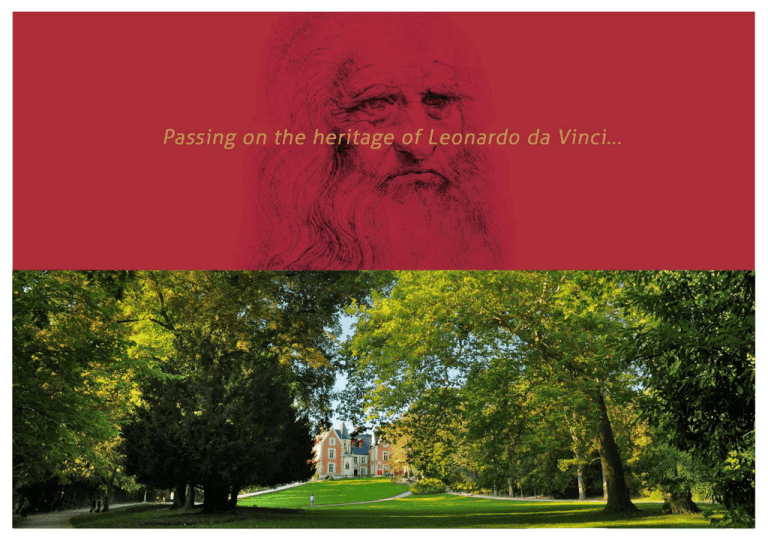
The Château du Clos Lucé Last residence of Leonardo da Vinci At the invitation of Francis I, Leonardo da Vinci came to live at the Château du Clos Lucé and stayed here for the last three years of his life, devoting himself to perfecting his inventions. Leonardo was prolific and inspired, working as an engineer, architect and theatrical director, organising lavish festivities for the Court. At his residence 400 metres from the Château Royal, he drew up plans for a model château for Francis I in Romorantin and designed the double-helix open staircase in the Château de Chambord. The Château du Clos Lucé is dedicated to showing and explaining to the public the great knowledge acquired by the Italian Maestro. The residence of Leonardo da Vinci, with 40 of his fabulous inventions Owned by the Saint Bris family for nearly two centuries, the Château du Clos Lucé showcases Leonardo da Vinci's intuitive grasp of a wide range of subjects. Visitors can see his bed chamber and that of Marguerite of Navarre, fully restored, his kitchen, the Council Chamber, the chapel featuring frescoes painted by his disciples and 40 of his inventions in military engineering, urban development, mechanical engineering, flying machines and hydraulics. There are six 3D animated sequences explaining how Leonardo da Vinci's inventions work. The Parc Leonardo da Vinci: a landscaped trail in the footsteps of Leonardo da Vinci This walk around the château grounds introduces visitors to the sources of Leonardo da Vinci's inspiration. With 20 hands-on, life-size machines and 40 giant hangings featuring details from Leonardo da Vinci's paintings, the visitor is immersed in the world that inspired the great Maestro. Leonardo's Garden: "Everything is there" For the first time, in landscaped natural surroundings, the Château du Clos Lucé brings to life Leonardo da Vinci's botanical drawings, geological and hydrodynamic studies and landscape compositions. The double-decker bridge, designed by the Maestro and built by the master carpenters of the 'Compagnons du Devoir', is yet another reason to see the gardens, plants and waterfalls that Leonardo once admired in this very spot. 1516-2016 The 500th anniversary of Leonardo da Vinci’s arrival at the Château du Clos Lucé Mona Lisa's enigmatic smile comes to the Château du Clos Lucé In the autumn of 1516, Leonardo da Vinci accepted the royal invitation and at the age of 64 crossed the Alps on muleback with some of this disciples including Francesco Melzi and his loyal servant from Milan, Battista da Villanis. In his leather saddlebags, Leonardo brought with him from Rome all his notebooks and sketches, evidence of the richness and diversity of his oeuvre, and three of his major paintings: Saint Anne, the Virgin and Child, Saint John the Baptist and the famous Mona Lisa. According to an account by the secretary to the Cardinal of Aragon, who was visiting the Château du Clos Lucé, they saw, "the painting of a Florentine woman, done from life, at the instance of Giuliano de' Medici." Painted between 1503 and 1514, this work is an example of Leonardo da Vinci's famous sfumato technique, in which the edges are blurred and softened. These three works are today kept at the Louvre Museum in Paris. Saint John the Baptist - Paris, Louvre Museum Cultural season 2016 The cultural season 2016 celebrates the work of Leonardo da Vinci for the king Francis I, his major influence to the installation of the Renaissance in France and his legacy to our country. Mona Lisa - Paris, Louvre Museum EXCEPTIONAL EVENT 17 June - 31 December 2016 Exhibition: “From the Clos Lucé to the Louvre Museum, three masterpieces of Leonardo da Vinci” Sainte Anne, the Virgin and Child Paris, Louvre Museum Two must-see permanent exhibitions EXHIBITION: "LEONARDO DA VINCI, ENGINEER" Finding inspiration in the books he read, the research carried out by the engineers of Siena and a tradition of science and technology dating back to the Middle Ages and antiquity, Leonardo found a way of systematising knowledge and innovating through the power of his own inventiveness. The fifty models built from Leonardo da Vinci's designs illustrate his different engineering talents in aeronautics, industrial machinery, marine engineering, measuring instruments, mechanisms, civil engineering, architecture and military engineering. They explain who Leonardo da Vinci really was; not only an artist, civil and military engineer and courtier but also a curious and inspired indefatigable observer of nature. EXHIBITION: "LEONARDO DA VINCI AND FRANCE" The fascinating ten-year relationship between Leonardo da Vinci and three kings of France The exhibition presents the result of the studies, work and research that da Vinci carried out during his Milanese period from 1507 to 1513 and his French period from 1516 to 1519. The special connection that da Vinci had with France, supported by three kings, Charles VIII, Louis XII, and Francis I – and not forgetting the decisive role played by Louise of Savoy – was one of the reasons that the Renaissance period came to the Loire Valley. In 2013 some new unique items were added to the exhibition and collections. A replica of David and Goliath is on display in the room containing Leonardo da Vinci's equestrian drawings. Cast between 1430 and 1432 by Donatello, it is considered to have been the first great bronze produced since antiquity. Other new exhibits include a mechanical interpretation of the Lion Automaton built from Leonardo da Vinci's manuscripts1. This unique piece took 3,000 hours to build and comprises mechanical parts made of iron, wrought in a forge, cut up with a saw and shaped with a file. Also not to be missed is an antique edition of Leonardo da Vinci's Treatise on Painting, the first French folio edition. The writings of Leonardo da Vinci were not published until a century after his death. The bilingual French-Italian edition of this work was published for the first time in Paris in 1651. Practical information Château du Clos Lucé - Parc Leonardo da Vinci 37400 Amboise - France Tel.: +33 (0)2 47 57 00 73 - Fax: +33 (0)2 47 57 62 88 Email: infos@vinci-closluce.com - www.vinci-closluce.com Location In the centre of the town of Amboise, 400 metres from the Château Royal d'Amboise. - 25 km from Tours (20 minutes) - 10 km from Chenonceau Opening dates The Château du Clos Lucé - Parc Leonardo da Vinci is open all day every day all year round (except 25 December and 1 January). The landscaped walk is open fully in high season only, from March to November. Opening hours Closing of the castle and the park one hour after the ticket office. January: 10am - 5pm February – March: 9am - 6pm April – June: 9am - 6pm July – August: 9am - 7pm September – October: 9am - 6pm November – December: 9am - 5pm Getting there By road: Paris-Amboise via the Autoroute Aquitaine A10 (exit Château-Renault-Amboise). 210 km, 2 hrs 15 By rail: Paris-Tours-St Pierre des Corps, 1 hour by TGV (the station is 20 km from Le Clos Lucé, with connections by rail or road) or Paris-Amboise direct in 2 hours (Amboise station is 2 km from Le Clos Lucé) By air: airports at Amboise-Dierre (15 km) and Tours (25 km)
